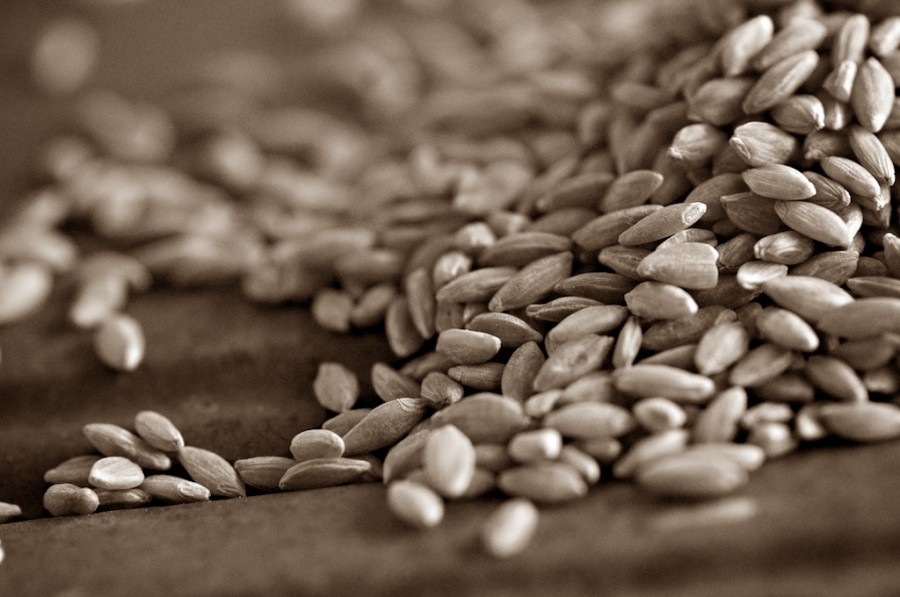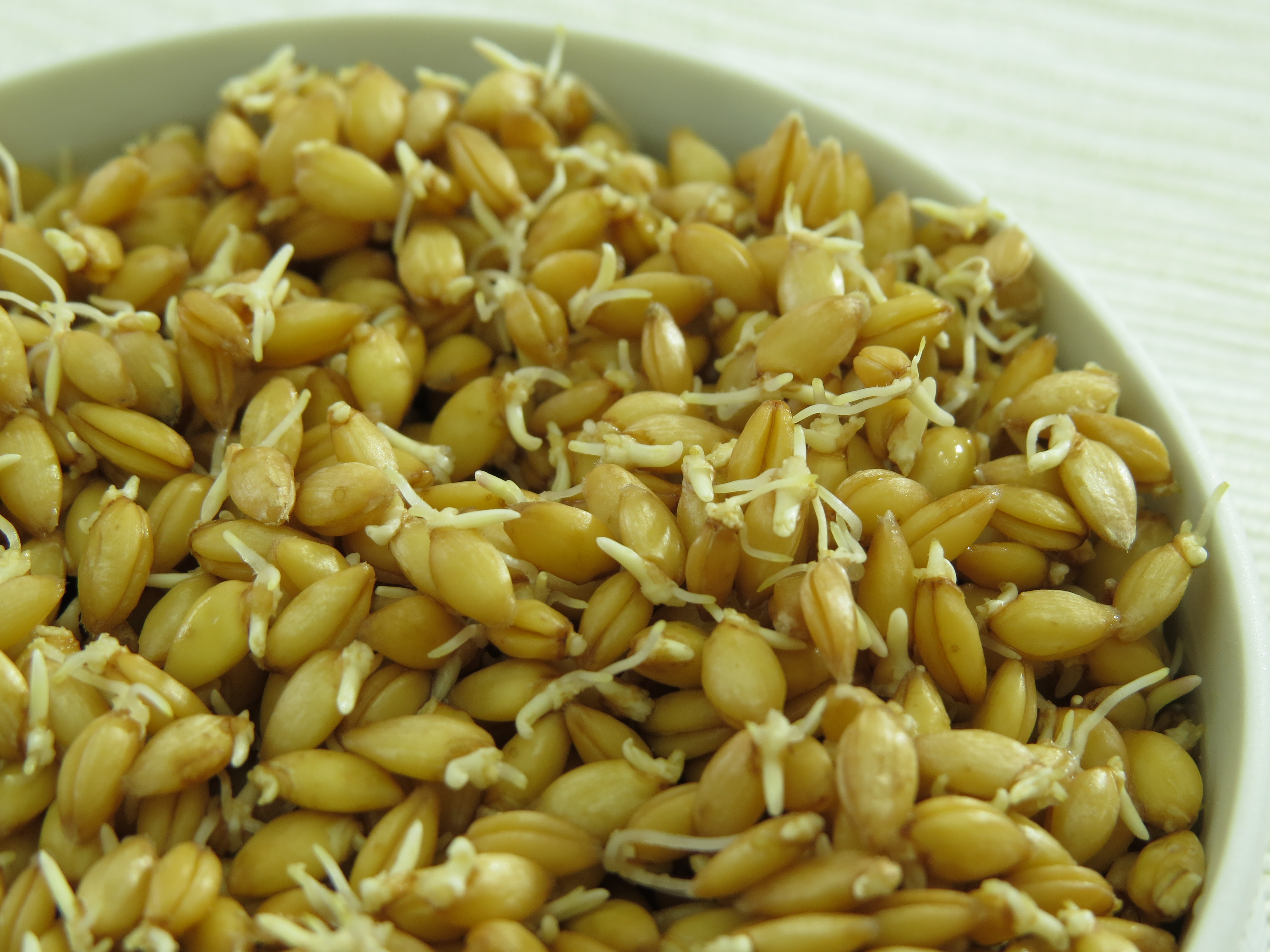Scientific research proves the advantage of einkorn over spelt and wheat on account of their content of phosphorus, potassium, vitamin B2, vitamin B6, vitamin A, provitamin A and proteins.
The great scientific interest in einkorn at present day arises with scientific discoveries (Auricchio et al, 1982; Favret et al, 1984,1987) (1, 2), which confirm that the proteins in einkorn are not a factor causing coeliac disease or other similar toxicity in the human body.
A team of Canadian scientists conducted a two-year precise Polish experiment, realized in five different regions in central Saskatchewan, Canada (3). They did an evaluation and comparison of the content and nutritional features of einkorn, spelt and conventional hard wheat. In conclusion, the scientists emphasize that einkorn is more nutritious and prove its superiority over spelt and hard wheat according to their content of wholesome proteins, phosphorus (P), potassium (K), riboflavin (vitamin B2), pyridoxine (vitamin B6), β-carotene (provitamin A) and retinol (vitamin A):
- Highest content of phosphorus (P) – Estimated level of P for einkorn is 415mg/100g in comparison with a lower estimation for spelt – 350-370mg/100g, and for wheat – 360mg/100g.
- Highest content of potassium (K) – estimated level of K for einkorn is 390mg-100g in comparison with a lower estimation for spelt – 375mg/100g, and wheat – 305mg/100g.
- Higher content of riboflavin (vitamin B2) – estimated level of vitamin B2 for einkorn is 0.5mg/100g in comparison with a lower estimation for spelt – 0.14-0.17mg/100g.
- Highest content of pyridoxine (vitamin 6) – estimated content of vitamin B6 for einkorn is 0.49mg/100g in comparison with a lower estimation for spelt – 0.35-0.42/100g, and for wheat – 0.36mg/100g.
- Richest in β-carotene (provitamin A) – estimated level of provitamin A for einkorn is 914 IU/100g in comparison with a lower estimation for spelt – 286-782 IU/100g, and for wheat – 408 IU/100g.
- Richest in retinol (vitamin A) – estimated level of vitamin A for einkorn is 93.8 IU/100g in comparison with a lower estimation for spelt – 30.7-80.9 IU/100g, and for wheat – 42.6 IU/100/g.
- Grains and flour richer in proteins – estimated level of protein for einkorn is 16.0-16.5% in comparison with a lower estimation for wheat – 14.9-15.3%
* calculated with a retinol equivalent: 1 retinol equivalent = 3.33 IU vitamin A or 10 IU β-carotene
Similar results, establishing a greater content of proteins in einkorn, are also shown by other scientists - Acquistucci et al, 1995. In their research they publish a result of 16.7% on average for the content of protein in a grain of einkorn. Waines, 1983 (5) determines a higher content of protein in einkorn flour – 18.6%.
NOTE:
Significance of P, K, vitamin B2, vitamin B6, vitamin A, provitamin A for the body
Phosphorus – P (6, 7, 8, 9, 10), is a chemical element present in all living cells, which never occurs on its own. It is the second most common mineral in the body, after calcium. In the form of phosphoric acid, it becomes part of the composition of nucleic acids, which play a vital role for the synthetic processes in the living cell (DNA, RNA). The salts of phosphoric acid, mainly the calcium phosphate, are the basic building material of the bones of vertebrates. Large quantities of phosphorus are also present in brain matter. In human and animal bodies, the greatest quantity of phosphorus is contained in bones and teeth (up to 85%), muscles and nerve tissue. Phosphorus combined with lipids forms phospholipids, which are an essential building material for the cell membrane, cell walls in the entire body, and are of great importance for healthy brain activity. Phospholipids in bran cells also designate which mineral, nutrient or medicine should go inside or outside of the cell. Phosphorus has many more significant functions. It is necessary for the production and preservation of energy. It helps the body convert proteins, fats and carbohydrates into energy. As a component of nucleic acids – DNA and RNA, phosphorus is also responsible for the storage and transmission of genetic material. In addition, P activates enzymes and hormones, aids the supply of oxygen to tissues and the maintenance of a favourable pH level, acting as a buffer.
Potassium – K (11, 12), is a main intracellular element necessary for the development and support of young and healthy cells. Potassium is for soft tissue, what calcium is for bones and harder tissue. Together with sodium it participates in the maintenance of metabolism, stimulates kidneys in the elimination of metabolic toxins, regulates the heart rate and protects from toxic effects on the heart by cardiac glycosides. It addition, it participates in the regulation of the acid-alkaline balance, maintains a healthy skin. Many scientists classify the presence of potassium in the body as a synonym of a normal heart rate and intracellular cation exchange. By regulating water balance potassium aids blood pressure regulation, improves the flow of oxygen to the brain and the excretion of toxins. It also keeps the arteries mobile and flexible. One can receive potassium daily through the consumption of wholegrain foods, which have not lost their content of potassium, vitamin B complex, husk, aminoacids, vitamin E, etc., when processed and refined.
Riboflavin – vitamin B2 (16), also known as lactoflavin, is water-soluble. Vitamin B2 participates in the production of red blood cells and in this way cooperates with the movement of oxygen molecules inside the blood, strengthens the functions of the immune system and aids the body in the fight against different diseases and viruses. Together with other substances it assists the absorption of proteins and energy released from the digestion of carbohydrates. It facilitates the work of the urinary system, which benefits the colon. Vitamin B2 is also of great significance for the growth and development of the body, as well as its reproductive functions. Last but not least it keeps skin and hair healthy, and nails – hard. A deficit might occur with a shift towards an irrational diet – excluding all animal proteins, and/or fresh vegetables. A shortage of vitamin B2 can be easily noticed. Symptoms of the lack of riboflavin are fatigue, pain and bleeding in the eyes. The skin loses its softness and becomes dry. A riboflavin deficiency might lead to premature signs of aging.
Pyridoxine – vitamin B6 (16), is a part of the B complex and is water-soluble. It is released about 8 hours after consumption and similar to the rest of the B vitamins it should be acquired through the intake of whole foods or supplements. Vitamin B6 stimulates the proper assimilation of fats and proteins, and contributes to the transformation of tryptophan (a basic aminoacid) into niacin. Its presence is necessary for the formation of antibodies and red blood cells. Other beneficial effects are nausea relief and a reduction of problems, related with dryness of mouth and urinating. Vitamin B6 might decrease the need of insulin for diabetics, but if the dose is not conformed the process might result in a reaction of low blood sugar. Arthritis patients should also take B6. Pyridoxine has an optimal effect when combined with B1, B2, B5, vitamin C and magnesium. Low blood sugar and low glucose tolerance are symptoms of a vitamin B6 deficiency. This can be substantiated through testing. The intake of B complex vitamins separately might cause an imbalance between them, which on the other hand might cause a deficiency of some of the vitamins. Alcohol, caffeine, contraceptive pills, conservation and thermal treatment of foods, radiation and estrogen might cause the elimination of pyridoxine or limit its digestibility.
Retinol – vitamin A (16), is also called the growth vitamin. Some plants contain β-carotene (provitamin A), which transforms into vitamin A inside the intestines and the liver. Carotene is only being sucked into the intestines at the presence of fats. It provides normal eye sight, growth for the young organism, development of teeth and bones, strengthens the skin and the mucosa, regulates the activity of the thyroid hormone in metabolism, prevents sclerosis, etc.
β-carotene – provitamin A (13, 14, 15, 16) is a provitamin of vitamin A. It takes part in the synthesis of proteins and antibodies – immunoglobulin. Increases the growth and development of bones, protects buccal mucosa, nose, throat, respiratory tract and lungs. It is used as an additional active ingredient in the treatment of emphysema and overactive thyroid. β-carotene nourishes the visual rods and cone photoreceptors in the retina, and is directly linked with the normal functioning of the retina and macula, providing day, night and sharp central vision. On top of that it acts as a light filter for the eyes, which protects the lens of the eye from photo oxidation (13). β-carotene plays a role in cancer protection. Its preventive action is based on its ability to transform carcinogenic products into safe ingredients. β-carotene also stimulates the functioning of the immune system. It not only prevents tumors, but also counteracts atherosclerosis by decreasing the risk of coronary incidents (myocardial infarction, sudden cardiac death) (15). According to observations, the Japanese and Norwegians, who are great consumers of food rich in beta carotene rarely suffer from lung cancer, colon cancer, prostate cancer, ovarian and breast cancer (14).
References:
1. AURICCHIO, S., DE RITIS, G., DE VINCENZI, M., OCCORSIO, R, and SILANO, V. 1982. Effects of gliadin-derived peptides from bread and durum wheats on small intestine cultures from rat fetus and coeliac children. Pediatr. Res. 16:1004.
2. FAVRET, E. A., CERVETTO, J. L., SOLARI, R. M., BOLONDI, A., MANGHERS, L. E., BOFFI, A., and ORTIZ, J. P. 1987. Comparative effect of diploid, tetraploid and hexaploid wheat on the small intestine of coeliac patients. (In Spanish)Page 13 in: Proc. 8th Meet. Latin- Am. Soc. Pediatr. Gastroenterol. Nutr., Sao Paolo, Brazil.
3. E.-S.M. ABDEL-AAL, P. HUCL, AND F.W.SOSULSKI, Cereal Chemists 72(6):621-624
4. ACQUISTUCCI, R., D'EGIDIO, M. G. and VALLEGA, V. 1995. Amino acid composition of selected strains of diploid wheat, Triticum monococcum L. Cereal Chem. 72:213.
5. WAINES, J. G. 1983. Genetic resources in diploid wheats: The case for diploid commercial wheats. Pages 115-122 in: Proc. 6thVInternational Wheat Genetics Symposium, Kyoto, Japan.
6. Linus Pauling Institute; Phosphorus; August 2007
7. DaVita.com; Phosphorus and Chronic Kidney Disease; October 2010
8. Phosphate Facts; Phosphorus -- Essential to Bone Health; November 2006
9. University of Maryland Medical Center; Phosphorus; Steven Ehrlich; June 2009
10 Ray Sahelian: Phospholipids and Their Health Benefits
11. HE FJ, MACGREGOR GA. Beneficial effects of potassium on human health. Physiol Plant. 2008;133(4):725-35.
12. HERMANSEN K. DIET, blood pressure and hypertension. Br J Nutr. 2000:83(Suppl 1):S113-119.
13. TEIKARI, J. Prevention of cataract with alpha-tocopherol and beta carotene. Investigative Ophthalmological Visual Science 33 (1992):1307.
14. THE ALPHA-TOCOPHEROL, BETA CAROTENE CANCER PREVENTION STUDY GROUP (1994). "The effect of vitamin E and beta carotene on the incidence of lung cancer and other cancers in male smokers". N Engl J Med. 330 (15): 1029–35. doi:10.1056/NEJM199404143301501.
15. LINUS PAULING INSTITUTE (June, 2009). "Micronutrient Information Center: Carotenoids". Oregon State University. Retrieved February 15, 2010.
16. wikipedia.org





 Where to buy
Where to buy